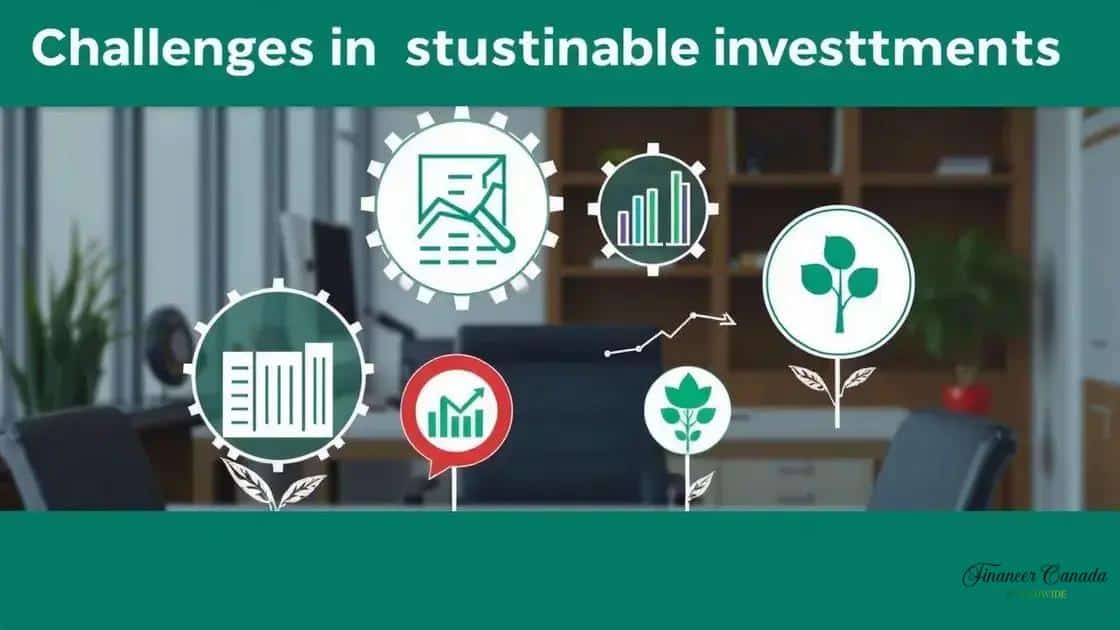Sustainable investment trends in 2025: what to expect

Integrating sustainability into your investment portfolio involves assessing current investments, defining sustainability goals, researching sustainable options, and monitoring progress to align financial objectives with environmental responsibility.
Have you ever wondered how sustainable investment trends in 2025 could influence your financial decisions? As we look ahead, understanding these trends is essential for making informed choices. Let’s explore what’s on the horizon.
Understanding sustainable investment
Understanding sustainable investment is crucial as we move towards a more eco-friendly future. This approach not only considers financial returns but also the positive impact on society and the environment.
What is Sustainable Investment?
Sustainable investment refers to investment strategies that prioritize long-term environmental sustainability alongside financial profitability. In simpler terms, it means putting your money into projects and companies that are not only profitable but also make a positive difference.
Key Principles of Sustainable Investment
When exploring sustainable investment, several principles come into play:
- Environmental impact: Investments should contribute to a healthier planet.
- Social responsibility: Investors consider the social implications of their choices.
- Long-term focus: Sustainable investments aim for longevity rather than quick profits.
Understanding these principles helps investors make informed decisions. Additionally, it is essential to recognize that sustainable investment encompasses various strategies, such as socially responsible investing (SRI) and impact investing, which focus on generating measurable social and environmental benefits alongside returns.
Furthermore, many organizations are adopting sustainability frameworks to guide their operations. These frameworks help ensure that businesses align with sustainable practices and address critical issues like climate change, resource depletion, and social inequality.
As demand for sustainable investment grows, so does the diversity of investment options available. Investors can choose from green bonds, ESG (environmental, social, and governance) funds, and other innovative financial products that support sustainability. This expanding availability makes it easier for anyone to get involved, regardless of their investment size.
Investing sustainably is not just about doing good—it’s also about recognizing that long-term investments in sustainability can offer robust financial returns. Investors are increasingly realizing that companies with strong sustainability practices often outperform their peers over time.
Ultimately, understanding sustainable investment involves recognizing the interplay between your financial goals and the broader impact of your investments. By choosing sustainable options, you contribute to a future that is not only financially sound but also beneficial for the planet and society as a whole.
Key drivers of sustainable investments in 2025

The key drivers of sustainable investments in 2025 are shaping the way investors approach their portfolios. Understanding these factors is vital for making informed choices and aligning with global trends.
Regulatory Changes
One of the most significant drivers of sustainable investing is the evolving regulatory landscape. Governments worldwide are implementing stricter regulations around sustainability, pushing companies to adopt greener practices. This shift creates new opportunities for investors interested in sustainable options.
Consumer Demand
Consumer preferences are also changing. People are becoming more conscious of their choices, seeking brands that prioritize sustainability. This demand encourages businesses to adopt sustainable practices, influencing investment strategies.
Moreover, as more consumers favor eco-friendly products, companies that embrace sustainability can improve their market positions. Investors are paying attention to this trend, recognizing that sustainable practices often lead to better financial performance.
Technological Innovations
Technological advancements play a crucial role in driving sustainable investments. Innovations in renewable energy, sustainable agriculture, and waste management are creating new investment avenues. As technology evolves, it becomes easier for companies to implement sustainable solutions.
- Solar and wind technologies are becoming more cost-effective.
- Electric vehicles are gaining traction among consumers.
- Smart agriculture tools enhance efficiency and reduce waste.
These innovations attract investors looking for growth opportunities in the sustainable sector, highlighting the importance of tech in driving sustainability.
Additionally, investors are increasingly considering environmental, social, and governance (ESG) factors in their decisions. Integrating ESG criteria helps investors identify companies that align with their values, further driving demand for sustainable investments.
This approach also highlights the growing recognition that sustainable practices can lead to competitive advantages and reduced risks in the long run.
In light of these drivers, it’s clear that the landscape of sustainable investments in 2025 is set for rapid growth. By staying informed and adapting to these changes, investors can position themselves to take advantage of new opportunities while contributing to a more sustainable future.
Sectors to watch in sustainable investing
As investors look towards the future, knowing which sectors to watch in sustainable investing is essential. Several industries are emerging as leaders in sustainability, offering exciting opportunities for growth.
Renewable Energy
The renewable energy sector is at the forefront of sustainable investing. With a global shift towards greener alternatives, companies in solar, wind, and hydropower are becoming increasingly attractive. These investments are not only eco-friendly but also poised for strong financial returns as demand rises.
- Solar energy is becoming more efficient and less expensive.
- Wind farms are expanding worldwide.
- Investment in energy storage solutions is increasing.
These advancements make renewable energy a key sector for sustainable investments in the coming years.
Sustainable Agriculture
Sustainable agriculture is another vital sector. As the world population grows, the need for sustainable food production becomes critical. Investors are focusing on companies that use environmentally friendly practices. These practices include organic farming, efficient water usage, and reduced chemical dependency.
Moreover, technology plays a significant role in transforming agriculture. Innovations like precision farming and vertical farming improve yields while minimizing environmental impact. This sector shows immense potential for growth and impact.
Green Building
The rise of green building practices emphasizes energy efficiency and sustainable materials. This sector includes eco-friendly construction, renovation, and real estate management. With increased regulations and consumer demand for sustainable living spaces, investments in green building projects are likely to grow.
Investors are noticing the long-term value of green properties, which tend to have lower operating costs and higher occupancy rates. These characteristics make green building an attractive area for investment.
Additionally, the technology sector is increasingly integrating sustainable practices. Companies that focus on reducing their carbon footprint through innovative solutions are gaining attention. This includes tech solutions for energy efficiency and waste management.
By keeping an eye on these key sectors, investors can position themselves advantageously in the sustainable investing landscape. The combination of financial growth and positive environmental impact is a powerful motivator for both investors and companies alike.
Challenges in sustainable investments

Understanding the challenges in sustainable investments is critical for investors looking to navigate this evolving landscape. While the opportunities are vast, several obstacles can hinder progress and investment effectiveness.
Regulatory Uncertainty
One major challenge is the lack of consistent regulations across regions. Different countries have varying standards for what constitutes sustainable investment. This confusion can make it difficult for investors to determine which projects truly align with sustainability goals.
Limited Data Availability
Another obstacle is the limited availability of reliable data. Investors need accurate information to assess the sustainability of potential investments. However, many companies do not disclose their environmental performance or sustainability practices, making informed decisions more complicated.
- Many sustainability reports are voluntary and lack standardization.
- Data collection methods vary, leading to inconsistencies.
- Access to comprehensive ESG metrics can be costly.
This lack of transparency can create challenges in evaluating risks and returns effectively.
Greenwashing Concerns
Greenwashing is another significant issue. Some companies may exaggerate or misrepresent their commitment to sustainability to attract investments. This practice misleads investors and undermines genuine efforts to promote sustainability.
Identifying truly sustainable companies versus those merely engaging in greenwashing requires due diligence and careful analysis, adding another layer of complexity to the investment process.
Moreover, the financial return on sustainable investments can be less predictable than traditional investments. Many sustainable projects, such as renewable energy infrastructure, require significant upfront capital, and the return on investment may take years to materialize.
Investors looking to dive into sustainable investments must be prepared for a long-term commitment. Additionally, market volatility can affect the performance of environmentally focused investments, which may steer some investors away from these opportunities.
Despite these challenges, there is a strong case for sustainable investments. The demand for environmentally responsible options continues to grow, and overcoming these hurdles is essential for unlocking the potential of sustainable finance.
How to integrate sustainability into your portfolio
Integrating sustainability into your portfolio is crucial for aligning your investments with your values. Recognizing the importance of sustainable investing can lead to both financial and environmental benefits.
Assess Your Current Portfolio
The first step in this process is to assess your current investments. Take a close look at what companies and sectors you are investing in. Are they actively pursuing sustainability? Understanding your portfolio’s carbon footprint is vital.
Define Your Sustainability Goals
Next, define your sustainability goals. What does sustainability mean to you? Determine which issues resonate most with you, whether they are renewable energy, social equity, or reduced waste. This will help guide your future investment decisions.
Research Sustainable Investment Options
Once you have a clearer idea of your goals, research sustainable investment options. Look for reputable funds that focus on environmental, social, and governance (ESG) criteria. Many companies are now recognized for their commitment to sustainability, making them attractive choices for your portfolio.
- Consider green bonds that finance eco-friendly projects.
- Explore ETFs that focus on companies with strong sustainability practices.
- Invest in firms that are leaders in renewable energy or sustainable agriculture.
Finding these investments requires thorough research, but the reward can be significant.
Another approach is to engage with sustainable investment advisors. These professionals can provide you with tailored advice on how to align your investments with your sustainability objectives.
Monitor Your Investments
It’s essential to monitor your investments regularly. Keep track of the companies you invest in to ensure they continue to uphold sustainable practices. As markets change, reassess your holdings and consider replacing underperforming investments with more sustainable alternatives.
Engaging in shareholder advocacy is another effective way to encourage sustainability. By voicing your opinions as a shareholder, you can influence companies to adopt more sustainable practices, driving positive change in the industry.
Incorporating sustainability into your portfolio is not just good for the planet; it can also enhance the potential for long-term financial returns. By choosing to invest sustainably, you can play a part in building a better future while working towards your financial goals.
FAQ – Frequently Asked Questions about Integrating Sustainability into Your Investment Portfolio
What is sustainable investing?
Sustainable investing focuses on choosing investments that not only provide financial returns but also contribute positively to environmental, social, and governance (ESG) issues.
How can I assess my current portfolio for sustainability?
You can review your investments to see if they align with sustainability principles, such as the company’s environmental practices and social impact.
What are green bonds?
Green bonds are fixed-income financial instruments specifically earmarked to raise money for projects that have positive environmental impacts.
How often should I monitor my sustainable investments?
It’s important to monitor your sustainable investments regularly, at least quarterly, to ensure they continue to meet your sustainability goals and to track their performance.





